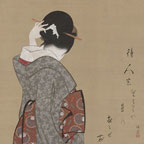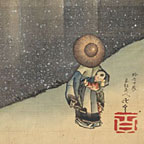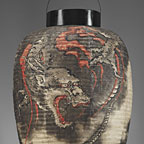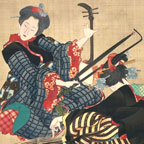NEWS FROM THE
FLOATING WORLD
Drama and Desire: Japanese Paintings from the Floating World,
1690–1850
Review by Gary
Gach
From August 28 to December 16, 2007
The Museum of Fine Arts, Boston (MFA) mounted an exhibition
of 80 works drawn from their collection of 700 ukiyo-e
paintings: Drama and Desire: Japanese Paintings
from the Floating World, 1690–1850. When
it reached Japan, it became clear this is the finest
collection anywhere in the world. From February 15
through May 4 2008, the exhibition was shown at the
Asian Art Museum of San Francisco, the last leg of
its two-year world tour.
(click
on the small image for full screen image with captions.)
|
Ukiyo-e [yoo-kee-oh-ey]
is translated as “pictures of the floating world,”
and generally refers to the genre of Japanese woodblock
print featuring motifs of seasonal landscapes, historic
tales, the theater, and the high-class red-light district
— these themes being themselves examples of the floating
world, the impermanence of life. (Think for a moment of
the lyrics to “Row, row, row your boat” and
you’ll catch the idea behind “floating world,”
an idea which also resonates with Buddhist nondualism: nirvana
is no different from samsara.) These prints, being “multiples”,
made art available for the common person, but also risked
later winding up as filler for packing a crate, hence retarding
their appreciation in the West as a cherishable art. Today,
however, such eminent ukiyo-e artists as Hiroshige,
Harunobu, Hokusai, and Utamaro are known by name, so we
can now really appreciate their paintings, a major source
of income for them, and in which their marvelous vision
and stunning technical skills finds fullest expression.
As we know, ukiyo-e blossomed
in Kyoto, Osaka and Tokyo (then “Edo”) beginning
in the 17th century. In Edo, then one of the world’s
largest cities, citizens lived literally under
military rule (the shogunate compound, with its vast retinue,
being situated up above). Naturally, there was a dynamic
between public and private life, as well as class difference.
So when an occasion arose, people let off steam and went
out: to enjoy music or thrill to a favorite actor at a theater
(kabuki), or to get together to write haiku, and maybe now
and then pay a visit to the Yoshiwara Pleasure Quarter,
if only to gawk at the spectacle of the trend-setting courtesans
and their retinue. Drama and Desire is divided
into three sections reflecting these popular activities:
Enjoyments of the Four Seasons; Dance, Drama and Kabuki;
and The Pleasure Quarters, Courtesans, and Geisha.
Merchants, samurai, and even the imperial
family would commission ukiyo-e artists who depicted these
everyday milieux to paint special screens and scrolls for
them. Composed on silk or paper, the paints were mineral
and vegetable pigments bound with glue binder, and their
ink was carbon from soot. Very fragile, such scrolls and
screens weren’t meant for display. They’re highly
refined and delicate, plus sensitive to light, shown on
particular occasions only.
 Fig. 1
Fig. 1 |
|
Yet they rebuff any quick viewing. Firstly,
their pigments forbade painting over, as a Western artist
might do, so the design must be carefully devised in advance,
and is the first thing one notices. Then one can appreciate
the spontaneity of the execution, one time only (yet another
dimension to the “floating world” idea). Then,
looking closer, subtle, telling details in execution are
a joy to discover. As MFA curator Anne Nishimura Morse expressed
to AsianArt.com during the press preview, they reveal themselves
over time. Quite so. Consider, for example, Woman Looking
at Herself in a Mirror (about 1805, relatively early
in the career of Katsushika Hokusai [figure 1]). Her back
is to us but the picture plane is offset with the mirror’s
alternate plane, reflecting her muted facial expression;
looking very closely, we can detect a brownish cherry substance
in her mouth, a medicinal cure for hysteria. She seems to
bite it as if looking forward to a night out.
The pattern on her outer kimono is all
hand-done, as it twists in and out of folds. Nuance of value
is highlighted in delicate white-on-white on the figure,
contrasting with the black and brown of her wooden stand.
Look sideways at the painting and you’ll see the shine
of mica and gold, (“sparkly” being almost an
aesthetic category of its own in Japan). Finally, looking
carefully one notices the neutral-seeming background actually
has a pinkish aura, from the backing behind the painting,
soaking through the material of the scroll itself, as if
faintly blushing.
|
 Fig. 2
Fig. 2 |
Such keen expressivity and finesse could
only be hinted at in a woodblock (a medium given to execution
by apprentices), but in painting Hokusai gave free rein
to his eccentric genius. Complementing that work, on an
opposite wall of the Asian Art Museum is his very poignant
picture of Li Bai viewing a waterfall [fig 2], painted as
Hokusai approached 100 years. Both waterfalls and the lives
of the poets were common themes of the day. But the viewers
witnessing a waterfall within a landscape, lending perspective
to the scene, were usually depicted at eye-level to the
viewer, seen picnicking perhaps along the banks with bento
boxes. Here, the viewer within the landscape, Li Bai, stands
at the bottom corner of the frame, almost trembling, gazing
up at a colossal waterfall, whose force is rendered as near
abstraction, 3,000 feet of falling water flying down Mt.
Lu, as if the Milky Way had fallen from the skies.
 Fig. 3
Fig. 3 |
|
Other objets d’art by Hokusai
include a pair of paper lanterns he adorned with traditional
tiger and dragon motifs [fig 1], the cylindrical form underscoring
their inter-relation, yin-yang. Plus there’s his bold
portrait of Zhong Kui [Shoki], this deity all in
vermillion on rough cotton, not a scroll but a a banner
intended to wave in the wind inspiring confidence on Boy’s
Day.
Besides Enjoyments of the Four Seasons,
which occupies one room of the Asian Art Museum, Dance,
Drama and Kabuki and The Pleasure Quarters, Courtesans,
and Geisha takes up another gallery. At the entrance
to the latter stands a wild eight-panel phoenix by Hokusai
[fig 4], inviting the imagination to spread its wings and
soar.
|
 Fig. 4
Fig. 4 |
The theater posters are some of the earliest
ever done and are very striking, in bold design and bright
primary colors. One poster is intriguing in combining a
number of scenes, one familiar to the theater-goer of the
day, one as yet unknown. Portraits of leading actors of
the day might seem today like the equivalent of a fan’s
posters, except they’re unique originals. One wall
is taken up by a a pair of large screens by Hishikawa Moronobu:
Scenes from the the Nakamura Kabuki Theater and the
Yoshiwara Pleasure Quarter. It’s an apt juxtaposition.
Just as the theater had its box seats for the upper classes,
and lower tier for the plebians, so too were the courtesan
“stars” ranked into grades. Only a few could
even dream of the courtesans at the top, much less afford
them: yet they might commission a painting to take back
as a souvenir of their visit to the walled pleasure quarter,
where the parade of beauties was a carefully choreographed
spectacle. (If the clothes in this painting seem exceptional,
by the way, chalk it up to Moronobu coming from a family
of embroiderers.)
 Fig. 5
Fig. 5 |
|
A painting by Hokusai’s daughter,
Katsushika Oi, Three Women Playing Musical Instruments
[fig 5] depicts a courtesan, a geisha, and an apprentice,
seated in a circle. Each clearly distinguishable by their
clothing, they flow together in a sensuous ecstasy of music.
Yet the painter, being a woman, seems conscious of what
their life had to be like. Look carefully at the red fabric
on the underside of the central figure, the courtesan with
her back to us, and you’ll see butterflies; zoom in
and you’ll see white lines: spiderwebs, the literal
underside of a costume becoming figurative as well, hinting
at unseen subterranean dangers.
Controlled spontaneity, detail, and especially
the role of backgrounds, are all integral to the show’s
erotic paintings (shungha) [figs 6-9], a fractional
selection of the hundred from Dr. Bigelow’s collection.
The mere idea of collecting them, back then, was unheard-of;
and, until 1985, only male curators were given a key to
see them. Needless to say, they are ... fascinating.
It’s quite an impressive exhibition.
Given that so many of these works have never been shown
since acquisition, they look as vivid and fresh as if painted
only yesterday. We must credit Dr. William Sturgis Bigelow
(1850–1926) who’d purchased hundreds of artworks
for the Museum of Fine Arts. Apparently, he escaped a dysfunctional
household and went to Paris to study under Louis Pasteur.
Japonisme was all the rage there, and he soon visited Japan
with Ernest Fenollosa. Dr. Bigelow wound up staying for
seven years, and took refuge in the Dharma. This was just
after Japan ended her long policy of isolation, so there
weren’t many collectors to compete with. He’d
often travel with Okakura Kakuzo, who became the MFA’s
curator of Japanese art. Until recently, it was believed
Messrs. Fenollosa and Okakura were Bigelow’s sources
as to what to buy, (they were instrumental in Japan’s
designating works as national treasures), but today we realize
how much Bigelow was his own man.
In 1996–7, a team of Japanese scholars
joined the MFA to catalogue their holdings of ukiyo-e paintings
for the first time. Not only did they discover they had
the finest collection anywhere in the world, but a re-evaluation
of Japanese art history is now possible, and necessary.
For those unable to attend the exhibition,
special thanks are owed to MFA curator Anne Nishimura Morse
who edited the catalogue. With essays and contributions
by leading scholars of Japanese art, it will be considered
a touchstone for decades to come.
- Gary Gach
|